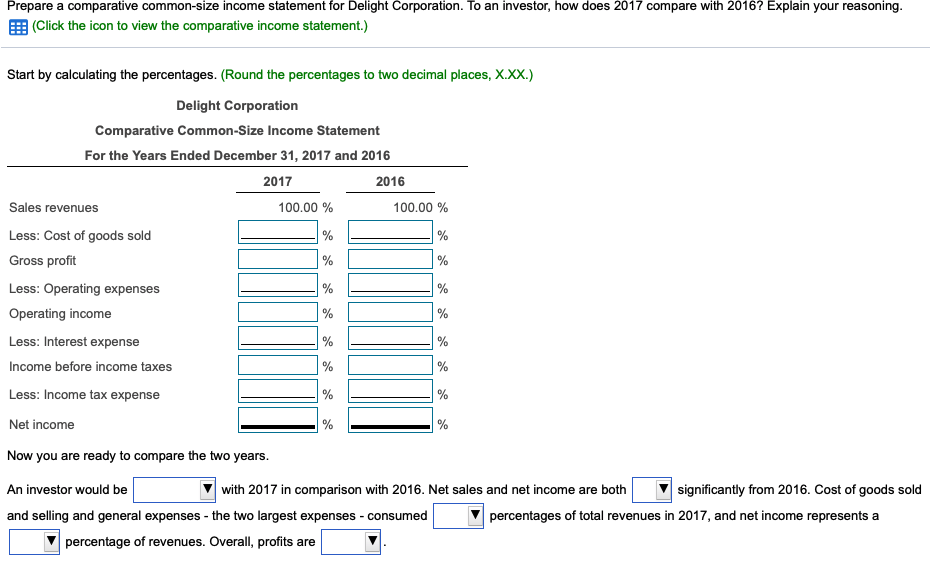
The income statement equation is sales minus expenses and adjustments equals net income. This is why the common size income statement defines all items as a percentage of sales. The term “common size” is most often used when analyzing elements of the income statement, but the balance sheet and the cash flow statement can also be expressed as a common size statement.

Understanding Common Size Financial Statements
This analysis lets you see how effectively you’re leveraging the cash in your business, beyond just dollars flowing into and out of your bank account. To perform a common size income statement analysis, you’ll compare every line on your profit and loss statement to your total revenue. In other words, net revenue will be the overall base figure on your common size analysis formula. Chances are, you already do at least a partial common size income statement analysis each month. Whenever you analyze your margins — gross profit, net profit or operating — you’re performing a common size analysis.
The Common-Size Analysis of Financial Statements
When figures are expressed as a percentage of a whole, analysts can assess how each part contributes relative to another. Although the information presented is useful to financial institutions and other lenders, a common size balance sheet is typically not required during the application for a loan. The main difference is that a common size balance sheet lists line items as a percentage of total assets, liability, and equity, which is different from the normal numerical value. Common size financial statements reduce all figures to a comparable figure, such as a percentage of sales or assets. Each financial statement uses a slightly different convention in standardizing figures.
- ” So, the search for efficiencies and improved performance begins again.
- The goodwill level on a balance sheet also helps indicate the extent to which a company has relied on acquisitions for growth.
- Assume Sporty Shoes has just completed its first year of trading.
- A common size financial statement displays items as a percentage of a common base figure, total sales revenue, for example.
Calculate the Cost of Goods Sold (COGS)
This analysis indicates that 40% of the revenue is consumed by production costs. This shows that Sporty Shoes’ increased cost of goods is not as bad as it first appeared. It could be that at least a part of it was due to factors beyond its control. For what is the saver’s credit example, weather conditions might have reduced the production of a raw material it needs and hence increased the price. FAST (Finance and Strategy Toolkit) is the membership program that gives you resources for better strategic financial management.
A Critical Skill for Business Leaders
Another commonly cited ratio is net income as a percentage of revenue. Of course, owners aren’t paid with income; they receive their distributions in cash. Profitability describes one aspect of a company’s financial performance.
Also known as the profit and loss statement, the income statement is an overview. It includes business net income, sales, and expenses over a reporting period. To find net income using the income statement equation, you simply minus sales from expenses. With this in mind, read on as we take a look at exactly what a common size financial statement is. As well as lay out the formula for you, describe the different types, and show you the limitations of common size analysis. Common Size Income Statement presents every line item available in the company’s income statement in the form of the relative percentage of sales.
A common size statement analysis lists items as a percentage of a common base figure. Creating financial statements in this way can make it much easier when it comes to comparing companies, or even comparing periods for the same company. A sample common size income statement helps in comparison of the proportion of various income and expenses within the profit and loss statement for the purpose of financial decision making.
As the equation indicates, the gross profit margin measures the gross profit a company generates for each dollar of revenue. Like in the case of the net profit margin, a higher gross profit margin indicates a higher level of profitability. But you can perform this analysis on your entire income statement, too. Doing so will help you see at a glance which expenses take up the largest percentage of your revenue.
Banks prepare quarterly call reports, which include a balance sheet, income statement, and many other financial schedules. The regulators create Uniform Bank Performance Reports (UBPRs) from those, which anyone can get from the internet. This company’s debt-to-asset ratio isn’t too high, but a better test is the ratio of annual operational cash flow divided by annual debt service payments. It standardizes financial data, making it easier to compare with other periods or companies, irrespective of their size. Divide each line item by total revenue and multiply by 100 to express it as a percentage of total revenue.


